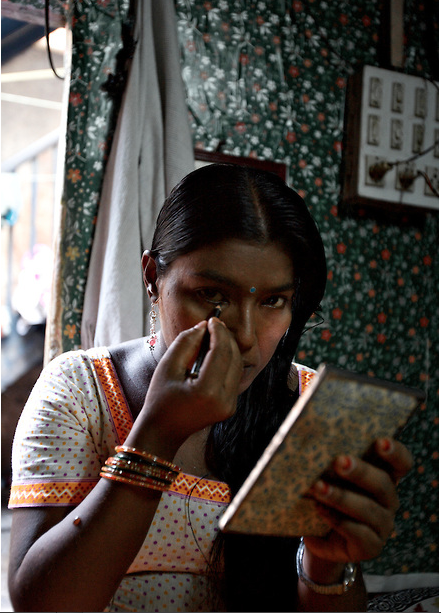

Hajra, Mumtaz, and Sheinaz take a break from fieldwork in a red-light district in Solapur, South Maharashtra. The three women work as peer educators with SAI, an NGO based in Mumbai.
A customer at the brothel in 14th Lane, Kamathipura. Many of the clients have problems with drugs and alcohol, which can make them violent.
Hajra is covered in scars from being beaten, tortured, and burned, with both cigarettes and kerosene. Shown here are burns from a previous partner who set her aflame in front of her two children. She was forced to jump from a first-floor window to escape.
Gambling, a nightly ritual in the red-light districts of Mumbai, along with drinking and drug use—14th Lane, Kamathipura.
Hajra and Sheinaz live in the same room and work in the same brothel. Many of the women look out for each other.
Shaila and her young son are terrified as Shaila's pimp has found her after she ran away and is taking her back to her previous brothel where she was constantly beaten and abused.
The threat of violence is always in the air.

Seven-year-old Laxmi stands in front of the room she shares with her mother Sangita in a brothel on Hauman Galli. The room is also her mother's place of work.
Sony used to dance in a bar until it was closed down. She now works in a hotel, standing on a stage with other girls until a client chooses her.
Hajra waits with family and friends outside the trauma care unit of a Mumbai hospital for news of Mumtaz, who was admitted with burns to 85 percent of her body after being set on fire.
Family members have to hold Durga, 23, Mumtaz's eldest daughter back as she tries to throw herself upon her mother's body. Durga is a widow and has two children of her own.
Mumtaz, 35, died from septicemia after having been covered in kerosene and set aflame. The police report states the cause of death as suicide, but her family believe she was murdered by her partner.
Mumtaz's sister and eldest daughters wait outside the funeral ground while her body is cremated. Her 18-year-old daughter was getting married as her mother was admitted to hospital.
Mumtaz's body is prepared for cremation in accordance with traditional Hindu customs and beliefs.
Mumtaz's relatives grieve for her as her body is cremated.
Violence against sex workers in India is a huge problem. However, the official statistics are unknown as incidents are rarely reported to the authorities, and when they are, very little is done.